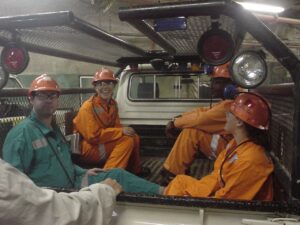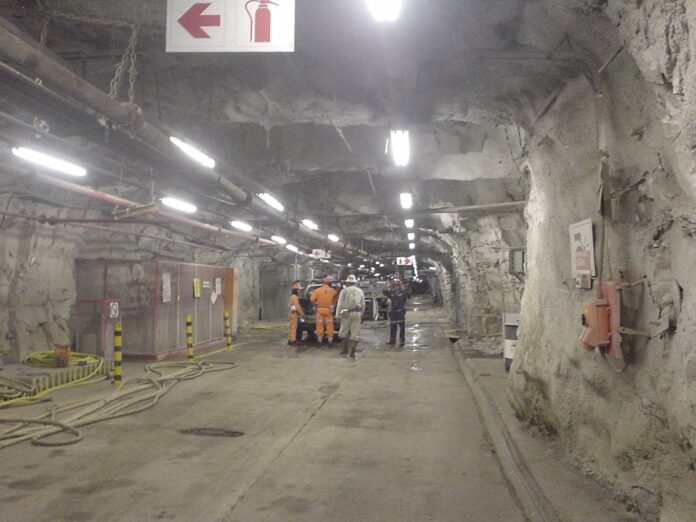
Electricity is the lifeblood of the country. If it stops flowing, the economy immediately starts to decay. The average citizen notices it immediately when the electricity stops flowing, because the kettle does not work and the lights go out. So there is an instant public reaction.
The public demands ‘a solution’.
So people look for a ‘quick-fix’.
Unfortunately, it is not so easy; it is far more difficult to generate electricity than people realise. Coal power stations are huge; you can park a couple of Boeings inside one, easily.
But the public wants a quick-fix to an electricity shortage so they jump at apparent solutions, such as solar panels and wind turbines. These renewable energy devices are not equal to a huge coal power station, not by any stretch of the imagination. There is also the added problem that solar is only available for part of the day, and not at all at night. Wind is only available when the wind blows, and you don’t know when that will be.
Imagine that you have just undergone open-heart surgery and you’re in the Intensive Care Unit, ask yourself; would I rather have the Intensive Care Unit attached to solar and wind power, or attached to coal or nuclear power?
If you are a miner working two or three kilometres underground in an inherently hot, dusty gold mine, that same question is most important too!
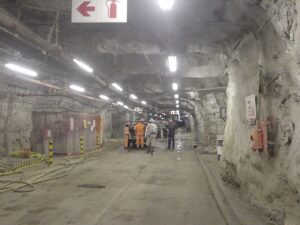
It is dangerous to be 2 or 3 km underground if the electricity fails
People these days are constantly coming up with all sorts of ideas for quick-fix energy, even though very many of the people concerned have no technology training. They say sea-wave energy; tidal energy; a wind energy device which works like a rotating washing line; use hydrogen; geothermal, as if all of these are ingenious new ideas. They are not; they are all very old ideas and were not adopted on a large scale for very good reasons.
Mostly, they were not adopted because they cannot produce large compact power, and also because they are very unreliable.
Here we have so far considered only technological questions, and the results for the ‘renewables’ are not so good. But now, unfortunately for renewables, if you add in economic factors the renewables become worse.
If society wants a continuously-running lifeblood of electricity, then the electricity must still flow when the sun is not shining and when the wind drops. What this means is that when a solar and wind combination is used, there must always be a reliable continuous alternative supply on standby; such as coal and nuclear.
But if a coal power station is standing idle much of the day because solar is being used and the wind is blowing, the staff at the coal station are still being paid. The costs at the coal station are still mounting. Those costs of idled coal plants must be added to the apparent costs of solar and wind, but that is generally not done. One has to ask: where do the costs of a coal-fired power station being kept in reserve in idle mode get added into the financial equation?
There are definitely valuable applications for solar and wind, but driving an electric train across the vast and arid South African Karoo, or operating a gold mine are not for them. Wind turbines can be used for pumping water up into a dam. Solar can be used for an application which only needs power over lunchtime.
The challenge is to find technologically sensible and economically viable applications for all energy sources. One has to remember that large wind and solar power generation came about as an apparent significant force as a result of political fears about possible climate change, and that climate may be altered by carbon dioxide emitted by industry.
One has to ask; what if that idea is actually wrong?
What if we have been led by the nose down the wrong path?

Realities of Africa
Let us now digress to consider the real size of Africa. Believe it or not, but Africa is larger than the United States, China, Europe, the UK and India added together. South Africa alone is the same size as the whole of Western Europe, and in addition the distance from Pretoria to Cape Town is the same as that from Rome to London.
The point is that solutions which may work for Europe, or appear feasible for Europe, are not necessarily at all applicable to African countries. African countries have to make their own decisions about their future. They have to choose energy systems which work for them.
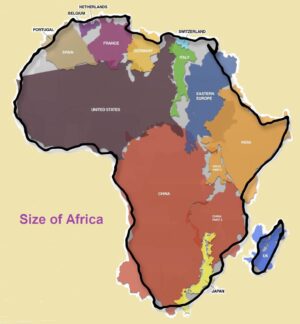
The continent is larger than China, the US, the UK, Europe and India added together.
African countries must not be persuaded by other countries to follow energy policies dictated by them, particularly when they are mainly in the interests of the ‘donor’ countries.
In the case of South Africa, which relies on coal for by far the largest fraction of its electricity, the coalfields are all in the far north-east of the country. So in transmitting electricity from the coalfields to the Cape area, the distance is further than Rome to London.
As a consequence, about half a century ago, South Africa decided to build a nuclear power station on the southern tip of Africa, near Cape Town.
The Koeberg power station started operating in 1984 and supplies about 50% of electricity for the Western Cape Province.
A really important factor in the case of nuclear energy is that so little fuel is required, so the transportation of fuel is not an issue in the slightest. In contrast, coal has to arrive at a coal station continuously, so coal plants need to be sited near to a coal mine. From a fuel delivery point of view you can position a nuclear plant anywhere.
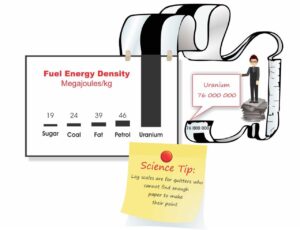
During the late 1960s and the 1970s there was significant building of nuclear power stations in a number of advanced countries, but this construction slowed down primarily due to vociferous anti-nuclear propaganda that was stirred-up in many countries around the world.
But in fact – reviewing in the 2020s the decades of past world nuclear power performance – it is clear that nuclear has turned out to be the cheapest, safest, cleanest and greenest of any energy source ever.
Reactors built in the 1970’s are still running today, producing inexpensive reliable electricity. Koeberg produces South Africa’s cheapest electricity.
Nuclear is safe
Contrary to much public belief, not a single person was killed by nuclear radiation at Fukushima; and in fact not a single person was even injured by nuclear radiation during the much-publicised incident.
The Fukushima incident was an amazing demonstration of a massive amount of power going out of control under the worst possible circumstances, and nuclear radiation did not harm anybody or any private property.
|
The Fukushima story was twisted The Fukushima incident could not have been a worse collection of factors all coming together… yet the drama unfolded such that one could not have had a better nuclear safety experiment had it been intentionally designed. The reactors were old, early models of Generation II; and they were sited on a dangerous coastline, a known area for earthquakes. Then the largest earthquake on record struck. That produced a massive tsunami. The size of the tsunami exceeded the height of the defensive barrier wall. The tsunami also wrecked the entire district for kilometres around. There were some bad management decisions at the plant, and Japanese procedure in certain respects was poor. What a combination of factors! So what happened? What few people know is that there were two different Fukushima nuclear power stations; Fukushima Daini (meaning Number 1), and Fukushima Daiichi (meaning Number 2). The drama happened at Daiichi. When the earthquake struck, the ground shook. Automatic detectors at both Daini and a few kilometres away at Daiichi triggered plant shutdowns, as per design. At both sites, all the operating reactors shut themselves down successfully. The operators at both Daini and Daiichi must have breathed a sigh of relief. The fellows at Daini were justified, because at their plant reactors all closed down and everything was fine. But at Daiichi … 55 minutes later the tsunami’s wall-of-water arrived, and it was higher than the anti-tsunami protection wall. No such water arrived at Daini. When a reactor shuts down in emergency mode, cooling-water pumps have to run for about five days to remove residual heat from the reactor. With some motor cars when they are switched off after a long hot run, the radiator fan keeps running for a while to cool the hot engine slowly and carefully. That is the exactly the same reason a nuclear reactor needs some days of cooling; to remove residual heat. However, reactor cooling pumps run on incoming electricity supplied from the municipality. But the local Fukushima municipality had been smashed by the tsunami. There was no incoming electricity, so the electrical pumps failed. No problem, diesel back-up pumps kicked in. But there had been a poor management design decision, and the diesel supply tanks had been placed outdoors. They were washed away, so the diesel pumps only ran for a while on the fuel which was already inside the building. Then it ran out. So the third level of protection kicked in, the reactors switched to battery power. But the batteries had only been designed to last 8 hours. And we can go on… the roads were smashed-up, so no Police, Fire Brigade, Army, Air Force help was going to arrive. But those services had also been smashed-up in any event. World news reporters were screaming for answers every few minutes. There were more unfortunate factors, too, like a highly formalised internal reporting structure; yet in spite of all this, nobody was injured by nuclear radiation. That is an incredible indication of just how safe a nuclear plant really is. |

It is not reasonable to compare standards of the 1970s with those of the 2020s
Modern Nuclear technology is far advanced
Nuclear power technology has advanced dramatically over the past couple of decades, since the earlier boom in nuclear reactor construction of the 1970s.
Of course, by world technological standards the 1970s was a very long time ago, and technology has advanced considerably. Back then, the Internet did not exist; nor did email; there were no cell phones; there was no personal GPS; no non-stick frying pans; and no 2-in-1 shampoo….
Technological advances since then which are less visible to the public include the development of advanced metal alloys; composite materials; and electronic controls. Such developments have enabled huge advances in solar and wind technology, which is undeniable; but equally there have been huge technological advances in nuclear power which, strangely, huge sectors of society overlook and even try to ignore.
Does one really imagine that a nuclear reactor designed and built after, say 2010, is the same as one designed and built during the couple of decades after 1960? Are modern nuclear reactors really still stuck in a pre-Internet, pre-cell phone era? Clearly not!
So, if nuclear power performance has been so good over the past half-century, it will be even better during the coming half-century.
South Africa built the Koeberg nuclear power station to supply electricity from the South ‘upward’ to complement the coal-supplied electricity coming from the North ‘downward’; but there is still a huge space in-between that includes points of high electricity consumption, such as large mining complexes and major manufacturing centres.
So in 1993 a decision was made to start investigating the potential of developing a Small Modular Reactor (SMR) to be placed in South African areas where there were no major supplies of water. South Africa has minimal spare inland water.
So South Africa became the first country in the world to start designing a commercial SMR. The project grew to a significant size, with a total workforce of some 2,000 people; and by 2008 the reactor was ready to be built. The pressure vessel was ordered and it arrived in South Africa.
But 2008 was an ominous year.
That was the year of the great US-induced international financial meltdown when major US banks went bankrupt, and it was only a few months later in the following year that South Africa had an abrupt change of government. Those factors, and a few others, led to the PBMR project being put into a ‘pause mode’ not long after – from which it never emerged. Anti-nuclear propaganda worldwide was also in full swing, which very much influenced decisions.
The HTMR-100 emerges
What positive action did happen as a result of the PBMR programme is that a group of engineers and scientists from the PBMR project started their own project to design a cheaper, simpler and faster-to-build reactor as a derivative of the PBMR.
It was called the HTMR-100.
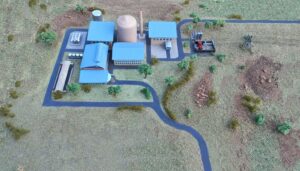

The HTMR-100 was designed for conditions like a typical South African mining community.Over the following number of years, the HTMR-100 was designed to the point at which it has been ready to build since 2020. The HTMR-100 is privately-owned but requires significant funding to move into constructing the First Of A Kind (FOAK) model.
Meanwhile, the team continues to work while also carrying out other nuclear development for foreign countries.
International opinion changes
A strong positive is that from about 2020 the international political climate started to swing in favour of nuclear, and during 2022 the swing accelerated dramatically toward nuclear.
A number of world leaders then found the courage to stand up in public and declare that their countries would move toward nuclear power and start new nuclear projects. Some African leaders stood up and announced that they saw nuclear power as the future for their countries. They are totally correct.
The realisation started to sink in that the world could not make progress into the future without the reliability of substantial nuclear power.
Journalists and youth groups have also come out pro-nuclear.
Even the European Union declared nuclear to be green for taxonomy purposes, thereby making nuclear not only respectable in the eyes of many EU politicians but also opening up avenues for green funding which previously had not been available.
Nuclear Fuel Development
South Africa also developed the fuel for the HTMR-100 reactor. It is known as TRISO fuel. The fuel was extensively tested in a number of countries over a 10-year period and it passed all the stringent tests.
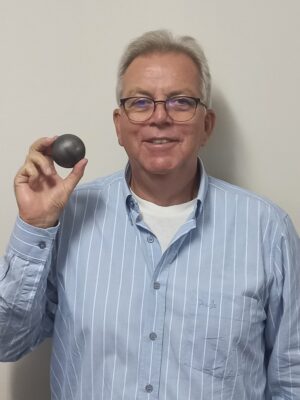
A TRISO fuel assembly now stands in Pretoria in a Care and Maintenance state waiting for customers.
Meanwhile, fuel development work continues for foreign clients.
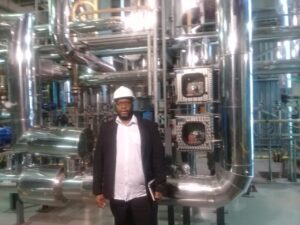
African Readiness
African countries and others around the world became interested in nuclear power as they realised the importance of solutions which really work for African conditions, or for the local conditions of diverse countries. A few African leaders have made powerful public statements about their intention to take their countries down a nuclear path. That is totally reasonable – by using Small Modular reactors which do not need large-scale water cooling.
African countries can also easily form a collaborative ‘club’ to link to each other with daily operations, training and regulatory oversight, among other functions. Such an approach will lower costs further, and also induce a spirit of cooperation that will be beneficial to all.
Advanced countries have also shown great interest in SMR systems for use in specific applications, or for smaller areas such as municipalities or specific industrial applications.
The HTMR-100 is now ready to build.
Investors need to have the confidence in an advanced energy solution development coming from Africa. Some established mind-sets need to change. The SMR from South Africa is an investment opportunity waiting for people with vision and some courage, and who also have some self-confidence and a belief in abundant and reliable green power for the future.
Dr. Kelvin Kemm is a nuclear physicist and Chairman of Stratek Global (Pty) Ltd., a nuclear development company based in Pretoria. Stratek Global is developing a South African SMR and carrying out project planning in a wide variety of fields for diverse clients.
[email protected] / [email protected]
| This article was derived from a presentation given at an energy conference held in Cape Town by The Afrikaner Action Initiative.
The conference was sponsored by the Konrad Adenauer Foundation. |
